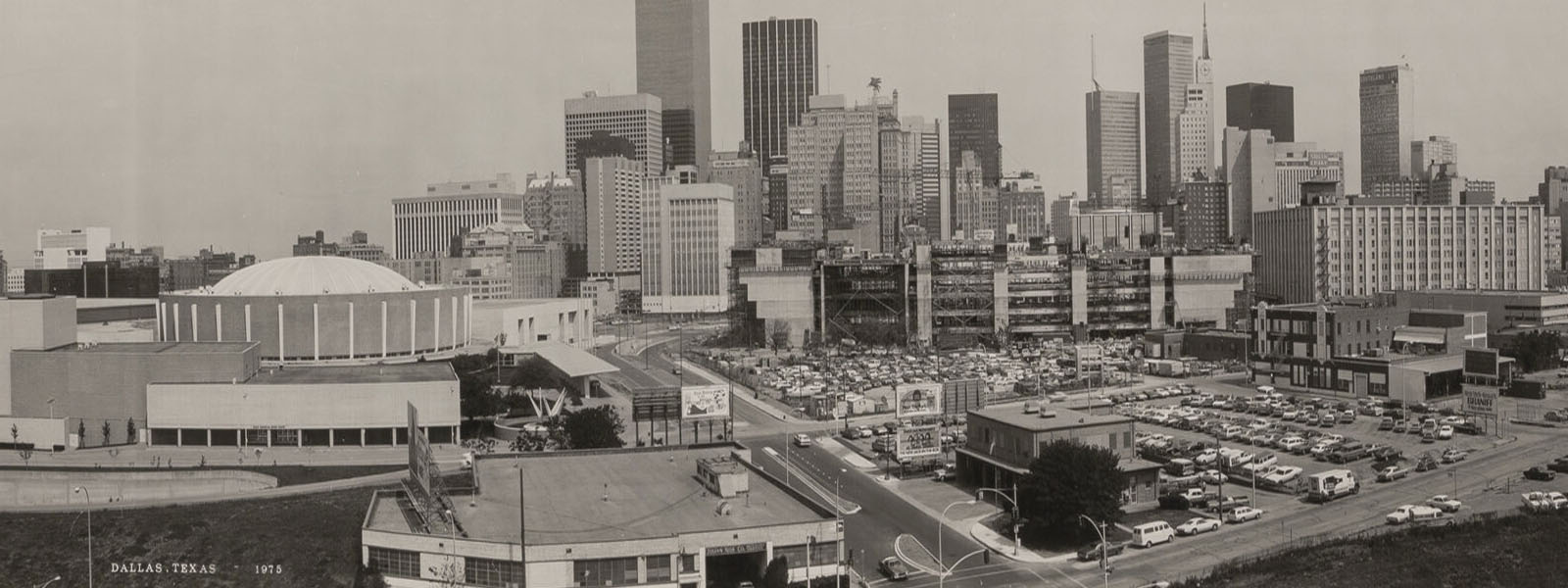A NEARLY 50-YEAR-OLD PHOTO BY A PANORAMIC PIONEER TELLS THE TALE OF A CITY ON THE VERGE
By Robert Wilonsky
The catalog entry says nothing and everything about this photo: “Downtown Dallas, Texas, 1975.” There are some details, yes: its size (about 9 inches tall by 48 inches wide) and a note that it’s signed and stamped on the back. And the photographer’s name is duly noted, too: Eugene Omar Goldbeck. But, really, it’s about what’s seen rather than said – a black-and-white picture of a burgeoning metropolis that looks like it was taken decades before Goldbeck snapped his panoramic. This image might as well be of Dallas on horseback.
Enlarge

Eugene Omar Goldbeck’s ‘Downtown Dallas, Texas, 1975’ (estimate: $600-$800) is available in Heritage’s July 12 Depth of Field: Photographs Showcase Auction.
For professional purposes, it’s perhaps most important to note that a Goldbeck panorama is significant – and valuable – no matter the subject. Even an out-of-print University of Texas Press book containing nothing but The Panoramic Photography of Eugene O. Goldbeck isn’t cheap – somewhere between $75 and $500, depending on where you shop.
According to the Texas State Historical Association, the San Antonio native started taking photos in 1901, when he was 9 years old and caught President William McKinley passing by in a parade. He was a panoramic pioneer who became the “unofficial photographer of America’s military,” per the TSHA. Then he turned his attention to his hometown and eventually to his home state.
“In 1967 Goldbeck discovered that many of his early negatives had deteriorated in storage,” the TSHA writes. “Distressed by this loss, he donated 60,000 of his negatives and more than 10,000 vintage prints to the Harry Ransom Humanities Research Center at the University of Texas.” You can browse his digitized works here courtesy the Ransom Center. This Dallas photo isn’t among their lot.
This photograph hails from the estimable collection of a local doctor who adored images of old Dallas as much as I; if you want this, we’ll have to fight over it, which I guess is what auctions are for. It’s easy to see why Dr. Paul A. Greenberg counted Goldbeck’s work among his possessions: It captures a Big American City in transition, its yesterdays on the margins while shiny tomorrow swallows the middle.
Enlarge

At the photo’s center, you see the Pegasus perched atop what was, upon its landing in 1934, Dallas’ tallest building: the 29-story Magnolia Building, the symbol for Magnolia Oil that, in time, would become the city’s unofficial mascot. Back in ’75 you could still see the rotating porcelain-and-neon flying horse miles away from the city’s center. I vividly recall being 40 miles northeast, in a small town called Farmersville, and seeing its red glow – a beacon toward home. The original Pegasus was replaced by a new version on New Year’s Day 2000; the first Pegasus is decidedly earthbound, having been planted on the lawn of Dallas’ Omni Hotel. Its replacement atop the Magnolia, now a hotel, is largely obscured by the skyscrapers that tower over the central business district.
I’ve spent most of my professional life writing about this city – some of it from a windowless office in the very building under construction at the center of the frame just beneath Pegasus. That’s I.M. Pei’s Dallas City Hall, which took five years to complete – June 1972 through December 1977 – and cost some $70 million, or $28 million more than initially budgeted. You’re seeing the rear of the building; from the front, you might better recognize the brutalist landmark as Omni Consumer Products headquarters from RoboCop.
Now, look to the far right of the photograph: That’s the former First Church of Christ, Scientist, which opened its doors in 1912, cost around $2 million in modern-day money to construct and is among downtown Dallas’ oldest structures. The building, designed by two of Dallas’ most famous turn-of-the-century architects and based on a Boston landmark, is a distressed and fractured version of its original self today. Its 2,373-pipe organ remains intact over the pulpit, but the last time I visited the sanctuary, it was disconnected.
Enlarge

The round-topped building on the left is the old Memorial Auditorium, another landmark designed by a famous architect, George Dahl, whose imprint is all over the city and who designed a building where I once worked. Two years before this photo was taken, my father checked himself out of the hospital to take me to see the Jackson 5 at Memorial on August 22, 1973 – my first concert. Elvis performed there, too, as did Led Zeppelin (repeatedly), the Who, Jimi Hendrix, the Doors, the Grateful Dead, Black Sabbath, Bruce Springsteen, David Bowie, Billy Joel, Elvis Costello, Prince and on and on. Memorial’s one of 26 venues the Beatles played on their 1964 North American tour. But the venue, long since swallowed up by a convention center about to get torn down and rebuilt yet again, hasn’t hosted a proper concert in years.
Some of the buildings captured by Goldbeck are long gone, leveled in the name of progress. Others have been repurposed and refurbished, from once-thriving office towers into hotels or apartments (or both). Among the survivors are the Mercantile Bank Building and its clock tower; the Dahl-designed First National Bank Tower with its illuminated pinstripes; and a building Dad took us to every Wednesday to deposit checks, the Republic National Bank Building upon which it seems a rocket ship has landed.
Every time I look at this photo – which is way too often of late – I note a detail I’d missed before: the absence of traffic on barren streets surrounded by islands of parking lots, the Braniff billboard advertising the hometown airline grounded for good just seven years later, the flatland just over the eastern horizon now filled with its sprawl of towers.
Heritage offers far more expensive photos than this Goldbeck image. But I can’t imagine I’ll ever find one I will treasure more.
For more information about Goldbeck’s Dallas photo or any of the other photos available in Heritage’s July 12 Depth of Field: Photographs Showcase Auction, contact Nigel Russell at 212.486.3659 or NigelR@HA.com.
 ROBERT WILONSKY is a staff writer at Intelligent Collector and former city columnist for The Dallas Morning News.
ROBERT WILONSKY is a staff writer at Intelligent Collector and former city columnist for The Dallas Morning News.

